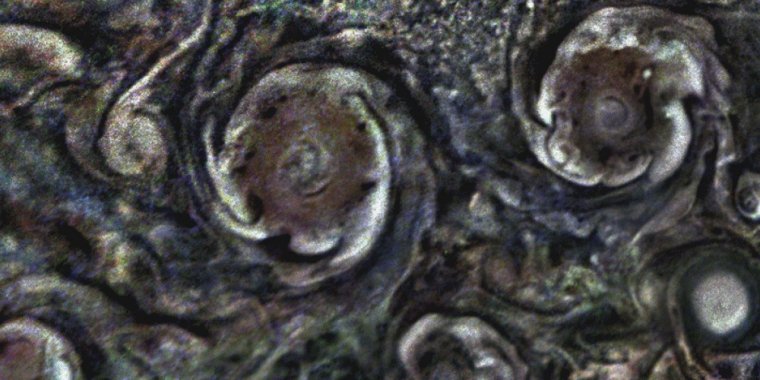| News / Space News |
NASA's Juno Spacecraft Updates Quarter-Century Jupiter Mystery
Twenty-five years ago, NASA sent history's first probe into the atmosphere of the solar system's largest planet. But the information returned by the Galileo probe during its descent into Jupiter caused head-scratching: The atmosphere it was plunging into was much denser and hotter than scientists expected. New data from NASA's Juno spacecraft suggests that these "hot spots" are much wider and deeper than anticipated.

The clouds on the periphery of some of Jupiter's polar cyclones rotate counterclockwise, while the core of the cyclones rotate clockwise. The JunoCam images were taken from altitudes of about 18,000 miles (28,567 kilometers) above Jupiter's cloud tops. Image data: NASA/JPL-Caltech/SwRI/MSSS
"Giant planets have deep atmospheres without a solid or liquid base like Earth," said Scott Bolton, principal investigator of Juno at the Southwest Research Institute in San Antonio. "To better understand what is happening deep into one of these worlds, you need to look below the cloud layer. Juno, which recently completed its 29th close-up science pass of Jupiter, does just that. The spacecraft's observations are shedding light on old mysteries and posing new questions - not only about Jupiter, but about all gas giant worlds."
The latest longstanding mystery Juno has tackled stems from 57 minutes, 36 seconds of data Galileo beamed back on Dec. 7, 1995.
When the probe radioed back that its surroundings were dry and windy, surprised scientists attributed the finding to the fact that the 75-pound (34-kilogram) probe had descended into the atmosphere within one of Jupiter's relatively rare hot spots - localized atmospheric "deserts" that traverse the gas giant's northern equatorial region.
But results from Juno's microwave instrument indicate that the entire northern equatorial belt - a broad, brown, cyclonic band that wraps around the planet just above of the gas giant's equator - is generally a very dry region.
The implication is that the hot spots may not be isolated "deserts," but rather, windows into a vast region in Jupiter's atmosphere that may be hotter and drier than other areas. Juno's high-resolution data show that these Jovian hot spots are associated with breaks in the planet's cloud deck, providing a glimpse into Jupiter's deep atmosphere.
They also show the hot spots, flanked by clouds and active storms, are fueling high-altitude electrical discharges recently discovered by Juno and known as "shallow lightning." These discharges, which occur in the cold upper reaches of Jupiter's atmosphere when ammonia mixes with water, are a piece of this puzzle.
"High up in the atmosphere, where shallow lightning is seen, water and ammonia are combined and become invisible to Juno's microwave instrument. This is where a special kind of hailstone that we call 'mushballs' are forming," said Tristan Guillot, a Juno co-investigator at the Université Côte d'Azur in Nice, France. "These mushballs get heavy and fall deep into the atmosphere, creating a large region that is depleted of both ammonia and water. Once the mushballs melt and evaporate, the ammonia and water change back to a gaseous state and are visible to Juno again."
Last year the Juno team reported on the cyclones of the south pole. At that time, Juno's Jovian Infrared Auroral Mapper instrument captured images of a new cyclone appearing to attempt to join the five established cyclones revolving around the massive central cyclone at the south pole.
"That sixth cyclone, the baby of the group, appeared to be changing the geometric configuration at the pole - from a pentagon to a hexagon," said Bolton. "But, alas, the attempt failed; the baby cyclone got kicked out, moved away, and eventually disappeared."
At present, the team doesn't have an agreed-upon theory regarding how these giant polar vortices form - or why some appear stable while others are born, grow, and then die relatively quickly. Work continues on atmospheric models, but at present no one model appears to explain everything. How new storms appear, evolve, and are either accepted or rejected is key to understanding the circumpolar cyclones, which might help explain how the atmospheres of such giant planets work in general. (NASA)
YOU MAY ALSO LIKE





